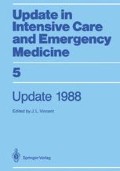Abstract
The benzodiazepins were introducted in the early sixties. Their various pharmacological properties and their high toxic/therapeutic ratio explain the wide development of their clinical use (and abuse?). Their mechanism of action on the central nervous system (CNS) was only elucidated in 1977 when high affinity binding sites, closely related to GABA-ergic synapses, were discovered in the mammalian cerebral cortex and related to the pharmacologic action of benzodiazepines [1, 2]. A specific antagonist of benzodiazepine-receptors (Ro 15-1788 — flumazenil), able to inhibit all the effects of classical benzodiazepines without inducing any own action, was discovered by Hunkeleer et al. in 1981 [3].
Access this chapter
Tax calculation will be finalised at checkout
Purchases are for personal use only
Preview
Unable to display preview. Download preview PDF.
References
Squires RF, Braestrup C (1977) Benzodiazepine receptors in rat brain. Nature 266:732–734.
Molher H, Okada T (1977) Benzodiazepine receptor: demonstration in the central nervous system. Science 198:849–851.
Hunkeleer W, Mohler H, Pieri L, et al (1981) Selective antagonists of benzodiazepines. Nature 290:514–516.
Mohler H, Richards JG, Wu JY (1981) Autoradiographic localisation of benzodiazepine receptors in immunocytochemically identified GABA ergic synapses. Proc Natl Acad Sci 78:1935–1938.
Polc P, Bonetti EP, Schaffner R, Haefely W (1982) A three-state model of the benzodiazepine receptor explains the interaction between the benzodiazepine antagonist Ro 15-1788, BZD tranquilizers, B-carbolines, and phenobarbitone. Naunyn-Schmiedelberg’s Arch Pharmacol 321:260–264.
Richards JG, Mohler H, Haefely W (1982) Benzodiazepine binding sites: receptors or acceptors? TIPS 3:233–235.
Mestre M, Carriot T, Belin C, et al (1984) Electrophysiological and pharmacological characterization of peripheral benzodiazepine receptors in guinea pig heart preparation. Life Sci 35:953–962.
Mestre M, Carriot T, Belin C, et al (1985) Electrophysiological and pharmacological evidence that peripheral-type benzodiazepine receptors are coupled to calcium channels in the heart. Life Sci 36:391–400.
Le Fur G, Vaucher N, Perrier ML, et al (1983) Differentiation between two ligands for peripheral benzodiazepine binding sites, (3H) Ro 5-4864 and (3H) PK 11195 by thermodynamic studies. Life Sci 33:449–457.
Hofer P, Scollo Lavizzari G (1985) Benzodiazepine antagonist RO 15-1788 in self-poisoning: diagnostic and therapeutic use. Arch Intern Med 145:663–664.
Lheureux P, Askenasi R (1987) Specific treatment of benzodiazepine overdose. Human Toxicology (in press).
O’Sullivan GF, Wade DN (1987) Flumazenil in the management of acute drug overdosage with benzodiazepines and other agents. Clin Pharmacol Ther 42:254–259.
Klotz U, Ziegler G, Reimann IW (1984) Pharmacokinetics of the selective benzodiazepine antagonist RO-15-1788 in man. Eur Clin Pharmacol 27:115–117.
Klotz U, Ziegler G, Ludwig L, Reimann IW (1985) Pharmacodynamic interaction between midazolam an a specific benzodiazepine antagonist in humans. J Clin Pharmacol 25:400–406.
Lheureux P, Askenasi R (1986) Benzodiazepine antagonist RO 15-1788 in acute alcohol intoxication. Toxicology Letters 31(s): 155 (abstract).
Louis M, Forster A, Suter PM, Gemperle M (1984) Clinical and hemodynamic effects of a specific benzodiazepine antagonist (Ro 15-1788) after open heart surgery. Anaesthesiology 61:A61.
Lheureux P, Askenasi R (1986) Treatment of benzodiazepine overdose with RO 15-1788. Arch Intern Med 146:1241 (letter).
Havoudjian H, Reed GF, Paul SM, Skolnick P (1987) Protection against the lethal effects of pentobarbital in mice by a benzodiazepine inverse agonist, 6,7-dimethoxy-4-ethyl-3-carbomethoxy-B-carboline. J Clin Invest 79:473–477.
Sage JD, Close A, Boas RA (1987) Reversal of midazolam sedation with anexate. Br J Anaesth 59:459–464.
Ricou B, Forster A, Bruckner A, Chastonay P, Gemperle M (1986) Clinical evaluation of a specific benzodiazepine antagonist (Ro 15-1788). Studies in elderly patients after regional anaesthesia under benzodiazepine sedation. Br J Anaesth 58:1005–1011.
Wolff J, Carl P, Clausen TG, Mikkelsen BO (1986) Ro 15-1788 for post operative recovery. A randomized clinical trial in patients undergoing minor surgical procedures under midazolam anesthesia. Anaesthesia 41:1001–1006.
Samson Y, Bernuau J, Pappata S, Chavoix C, Baron JC, Maziere MA (1987) Cerebral uptake of benzodiazepine measured by positron emission tomography in hepatic encephalopathy. N Engl J Med 316:414–415.
Baraldi M, Zeneroli ML, Ventura E, et al (1984) Supersensitivity of benzodiazepine receptors in hepatic encephalopathy due to fulminant hepatic failure in the rat: reversal by a benzodiazepine antagonist. Clin Sci 67:167–175.
Scollo-Lavizzari G, Steinmann E (1985) Reversal of hepatic coma by benzodiazepine antagonist (Ro 15-1788) (letter). Lancet 1:1324.
Bansky G, Meier PJ, Ziegler WH, Walser H, Schmid M, Huber M (1985) Reversal of hepatic coma by benzodiazepine antagonist (Ro 15-1788). Lancet 1:1324–1325 (letter).
Editor information
Editors and Affiliations
Rights and permissions
Copyright information
© 1988 Springer-Verlag Berlin Heidelberg
About this chapter
Cite this chapter
Lheureux, P., Askenasi, R. (1988). Clinical Use of Benzodiazepine Antagonists. In: Vincent, J.L. (eds) Update 1988. Update in Intensive Care and Emergency Medicine, vol 5. Springer, Berlin, Heidelberg. https://doi.org/10.1007/978-3-642-83392-2_65
Download citation
DOI: https://doi.org/10.1007/978-3-642-83392-2_65
Publisher Name: Springer, Berlin, Heidelberg
Print ISBN: 978-3-540-18981-7
Online ISBN: 978-3-642-83392-2
eBook Packages: Springer Book Archive

